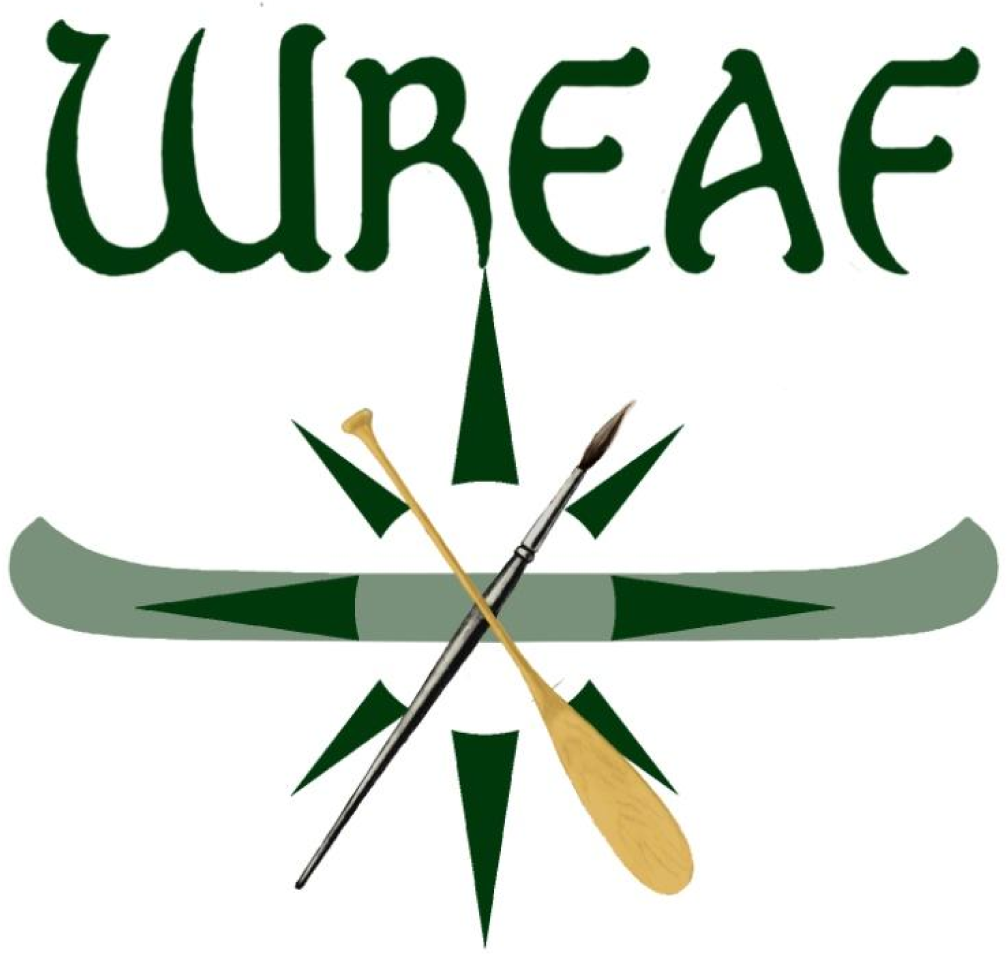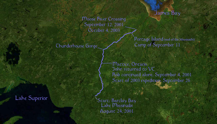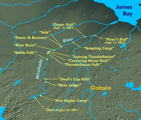

Missinaibi River - WREAF's Beginning:
300 miles; Missinaibi Lake to Moose River Crossing
(originally planned to run to Moosonee on James Bay)
August 24 - September 12, 2001
Crew:
Rob Mullen and John Pitcher: 130 miles, Lake Missinaibi to Mattice, Ontario.Rob Mullen: 170 miles, Mattice to Moose River Crossing.
The Missinaibi 2001 Expedition - By Rob Mullen
This expedition was the first in the on-going series that lead to the formation of WREAF in February 2005. It was far from my first wilderness canoe trip, but it was the first that was specifically planned as a painting trip.
For several years I had wanted to combine my painting with my love of wilderness canoeing, partly just for the adventure of it, but also to use the experience as a touchstone for the basic inspiration for my art. I was interested to see how total immersion in wilderness affected my painting compared to the extensive car and camera research trips that I, like many wildlife artists, relied on most of the time. I had done paintings from some of my past canoe trips, but had never brought my painting kit along on the rivers themselves. In the late nineties one thing or another had kept me from going. Finally I decided I would do it "Come Heck or High Water" in 2001.
It was to be a solo journey on Ontario’s Missinaibi River, from source to salt – over 300 miles. When fellow Vermont artist John Pitcher asked to come, I secured a second solo canoe by the generosity of Mad River Canoe Co. and magazine coverage with Wildlife Art Magazine.
The Missinaibi flows north and northeasterly from Lake Missinaibi 340 miles to the southern most extension of the Arctic Ocean, James Bay. The first 130 miles flow through remote, if not "wilderness" country to Mattice, Ontario. North of Mattice there is nothing but wilds for 170 miles to the Cree Indian village of Moose River Crossing.
John and I got under way on a bright and warm August 24, 2001
Low water and, later cold north winds, hampered our progress so that painting was difficult. Despite the arduous conditions we both got plenty of art done, and reached Mattice September 1st.
Both John and I are fairly tough travelers, but neither of us is twenty (or thirty or even forty) and we were both feeling the strain of the trip. John elected to return to Vermont from Mattice. I faced down my serious qualms about continuing by myself into real wilderness.
Going Solo
It was cool and blustery as I set off September 4th for James Bay. Alone, my attention was intensely focused on river, weather, wildlife and art. I was acutely aware that I was working without a net and that if I needed help, I could be out of luck; even a minor accident could be disastrous. Everything seemed keener, however, and my paintings took a quantum leap. That first day I reached Kettle Falls and was feeling a bit lonely as I set camp. As I started painting though, all trace of loneliness suddenly left me.
I reached Thunderhouse late in the afternoon of the 5th. Thunderhouse is as awesome as its name implies; especially being alone. The sense of power was palpable even though the low water gave it a sense of being held in check. The rain started on the 7th and the greatest physical and psychological challenge of the journey was enduring the next four days. A cold north wind joined the rain on the 8th and it was my most signal wildlife day; a huge bull moose nearly trod on me just before sunup in the cold drizzle, passing within three feet of my little tent and a few hours later a bear crossed the same small rapid I was running as I spun to a stop and watched from an eddy. Once across he seemed to notice me and approached quite closely before I peeled out of the eddy back into the current and he moved off.
Conditions grew steadily worse that day and I battled a strong headwind and building waves for 24 miles ending in a sobering brush with hypothermia (and two tame sandpipers who cheered me up the next morning). The crescendo was a screaming near- gale that roared in during the wee hours of September 10th.
In my isolated ignorance, the next day was the finest of the trip; a beautiful dawn (my first sight of the sun in days) with Sandhill Cranes, 31 miles of invigorating paddling (including an adrenalin moment in Deception Rapids), and a comfortable camp looking back at the last of the Missinaibi River. As the sun sank through stages of delicately nuanced evening light into riotous color I cooked dinner and painted.
Two days later at the Cree village of Moose River Crossing, I was told of what September 11th was to everybody else. I’d arrived and talked with many of the Cree there late the day before, but they had (as I was informed in the morning) decided among themselves not to tell me of the terrorist attacks immediately to spare me worry overnight. It was a consideration the value of which they couldn't have known. One of my brothers was on the Joint Chiefs of Staff, and I knew he was probably in the Pentagon when it was hit. A first cousin’s office was on the 103rd floor of the WTC. There were no phones at Moose River Crossing. I caught the southbound train but by the time I reached Cochrane, Ontario I almost didn’t dare call. I loaded the canoe out of the boxcar and secured all my gear before heading into the station and picking up the phone. My brother had indeed been in the Pentagon but was all right. My first cousin had by chance been called home while on his way to work and so was also alright; no one in his office made it out. It was a surreal return to the civilized world. It was two or three years before I could bring myself to paint my version of September 11th. Those paintings, "First Light" and "River’s End" are on this site.
I had, especially during my time alone, given a lot of thought to getting other artists to join me on future expeditions. Further I had the idea that by exhibiting the artwork that came out of such adventures we could have an effect on public opinion and build awareness of this wilderness and the threats it faces. My phone calls after returning to Vermont met with instant interest and the idea of a wilderness conservation project has built steadily since. WREAF grew directly out of these expeditions and was officially formed in 2005.


